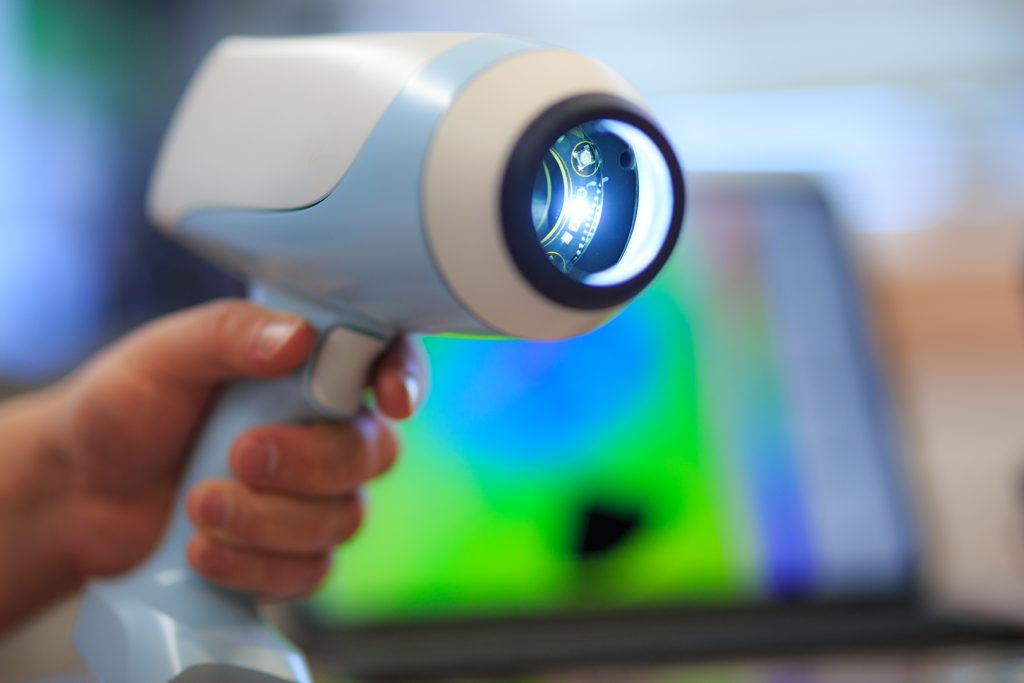
Bdetect multispectral imaging device
According to WHO data, skin cancers are the most common group of cancers in the world – around 1.5 million cases in 2022. Of these, 330 thousand are melanoma, from which 60 thousand patients died. As with any cancer, early diagnosis is critical to good outcomes, making it an excellent field for innovation.
Bdetect is the result of cooperation between two Latvian universities, says Dmitrijs Bļizņuks, associate professor of Riga Technical University (RTU) and one of the startup co-founders. The knowledge in medicine and photonics comes from the University of Latvia (LU), while engineering – from RTU. The device is relatively simple – the skin is illuminated with lights of different colors, which are dispersed and absorbed depending on the composition of the skin. During this process, images of the light reflected from the skin are taken. These images are uploaded to a server where algorithms are used to analyze, classify and determine whether the photographed skin growth is melanoma, another skin cancer, or one of the benign types of skin lesions.
One of the algorithms is mathematical and based on knowledge about the specific properties of human skin – a formula developed at LU, which can be used to calculate the proportion of skin chromophores (pigments), looking for a combination that is a characteristic of melanoma. The second algorithm is trained through machine learning, or what is known today as artificial intelligence. It is trained not only on melanoma, but on five different classes of skin lesions, of which melanoma currently has the highest accuracy (over 90%). Even though the device could be used to diagnose these other lesions, Dmitrijs emphasizes that the main focus is directly on the mathematical model and melanoma diagnosis.
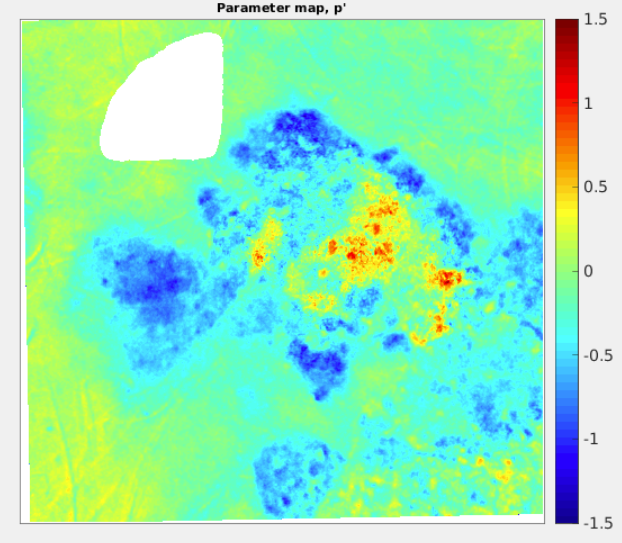
Lights of different colors are dispersed and absorbed depending on the composition of the skin.
From technology to practical use
LU has been working with multispectral analysis of skin formations for about 20 years, so in a way that makes Bdetect 20 years old as well. However, as a better starting point, we can choose the time around 10 years ago – when Dmitrijs met Ilze Lihačova, who at that time was a student at LU and started research for her doctoral dissertation. Together, the two decided to create a project on diagnosing melanoma with the help of a mathematical formula and successfully received European Regional Development Fund (ERDF) funding. As a result, the first Bdetect prototype was created between 2017 and 2019. Following that was another project at the Latvian Science Council, during which an artificial intelligence algorithm was added to the device’s functionality.
The first clinical study happened in cooperation with the Riga East Clinical University Hospital Latvian Oncology Center – images were taken of patients with skin diseases and the diagnosis was checked immediately with conventional methods. Currently, this same principle continues in Hungary, at Budapest’s Semmelweis University (Semmelweis University), which has several researchers interested in the analysis of skin formations, and a large flow of patients. “Currently, we have more than 4000 images of formations and a large part has been confirmed histologically,” says Dmitrijs. “All research publications are available on open access.”
Finally, in 2021, the commercialization of the project and the official founding of the startup took place. The team received a technology commercialization license from LU and – with the help of the Commercialization Reactor – were joined by the current CEO of Bdetect, entrepreneur Ronalds Skulme. “When we founded Bdetect, the technology developed in the universities was practically ready to be used,” says Dmitrijs. “Currently, we are improving the design of the device (where we received assistance from RTU Science and Innovation Center), the speed of operation, and the accuracy of the algorithms. We constantly obtain new data, which allows us to either retrain the artificial intelligence algorithm or adjust the formula of the mathematical model.” Currently, the team consists of three scientists, two entrepreneurs and a variable number of advisors – all of whom still have full-time jobs at other companies or universities.
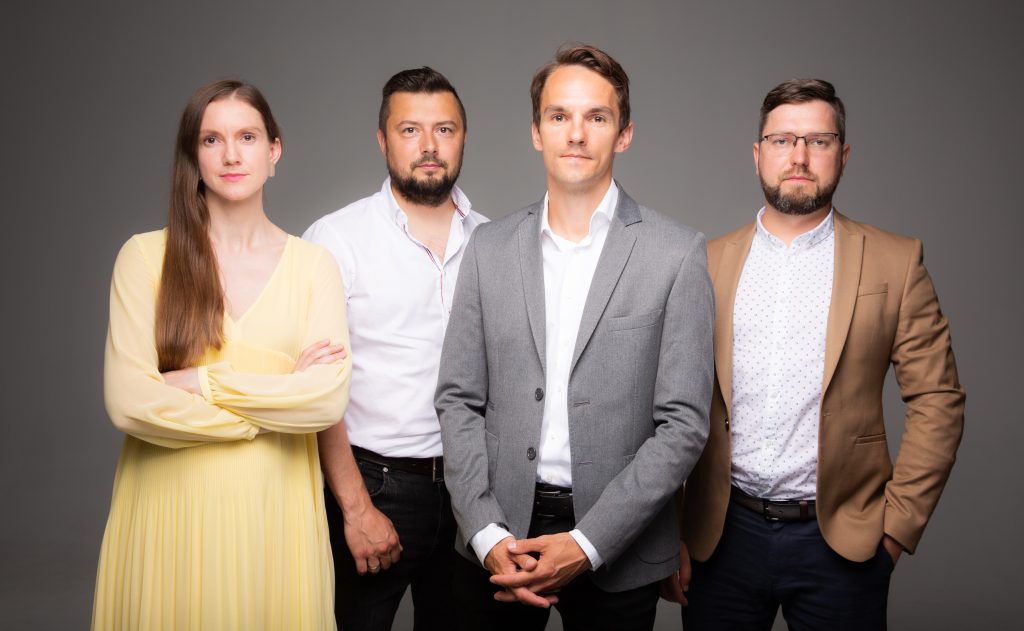
Bdetect core team. From the left: Ilze Lihačova, CMO; Aleksejs Lihačovs, CSO; Ronalds Skulme, CEO; Dmitrijs Bļizņuks, CTO.
A good tool in a dermatologist’s arsenal
Norbert Kiss, assistant professor in the Department of Dermatology at Semmelweis University and head of the university’s dermatology inpatient unit, often sees a variety of skin health problems, from cancer to rare diseases. N. Kiss has been cooperating with Bdetect team for more than five years: “The first time I saw their presentation was at the medical imaging conference held in Miami. I noticed the potential in their technology and initial research and decided that I could help with my knowledge in dermatology.”
N.Kiss explains that dermatologists already have dermatoscopes – currently the most widely used skin diagnostic device equipped with a light source and 10 times magnification: “But with the help of a dermatoscope you cannot see such fluorophores as melanin and carotene, which play an important role in the skin during the process of formation for various types of cancer (melanoma, squamous cell carcinoma, pigmented basal cell carcinoma, etc.). Furthermore, the arrangement of these molecules in the skin is very different in benign skin lesions. Finally, the interpretation of the image is assisted by artificial intelligence – an algorithm that has been trained to recognize this arrangement in cases of various diseases. This means that Bdetect device not only allows viewing the morphological structures of skin, but also effectively evaluates the molecular level.”
However, he also emphasizes that there are practical limitations to the use of the device – it is relatively large, and it cannot be used in places of the body that are difficult to reach (for example, between the fingers) or where there is not a large enough flat area (nose, ears, etc.). “Besides melanoma, there are several other diagnoses for which the sensitivity of the device is around 90% and the specificity is more than 80%. Not to mention other skin problems for which there is not enough data yet. However, there are also rare diseases where these features of melanin and carotene are not present, which means that a dermatoscope is better suited in those cases,” N. Kiss continues about the limitations. “Similarly with lesions located deep in the skin – in their case, ultrasound will be much more effective than multispectral imaging. Of course, biopsy is still going to be the gold standard, but it is an invasive procedure and usually follows and confirms the initial diagnosis, rather than competing with it.”
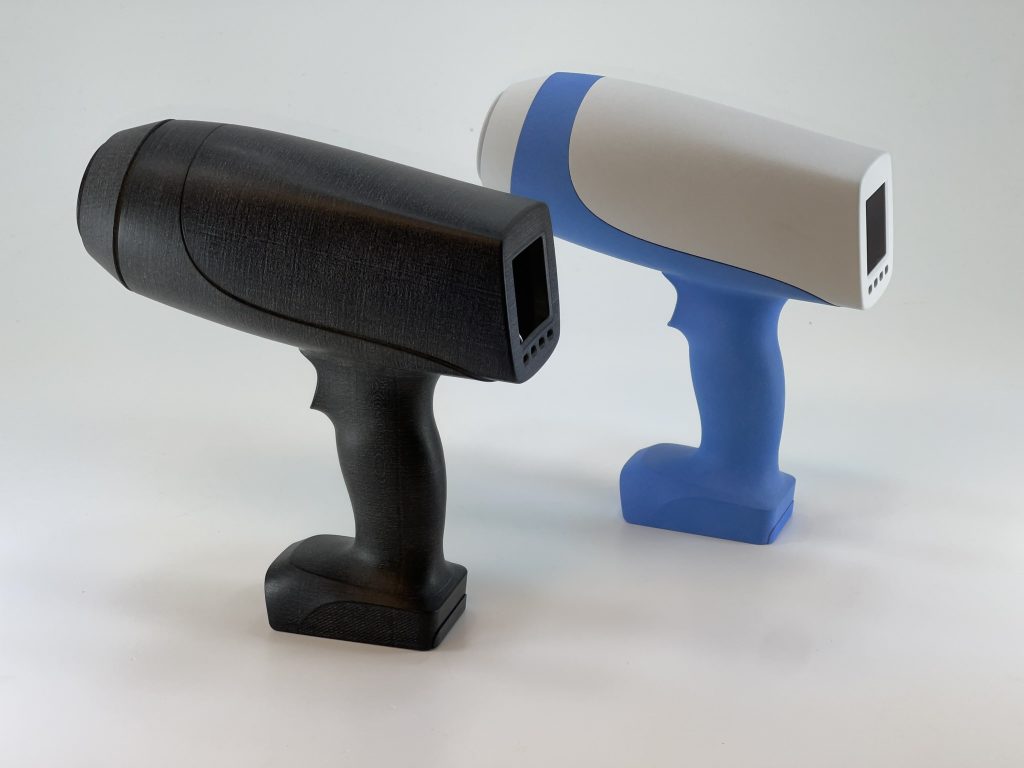
Prototypes of Bdetect device.
Added value
The beneficiaries of this machine could be not only doctors, but also beauty salons and any other place where people might want to check their skin. The operation of the device is very simple – press it to the skin so that room light does not reach the area, turn it on with one button, take a picture with another. You can immediately see the result on the device screen, which is also saved on a computer.
However, the main idea is to help family doctors and general practitioners who have a large flow of patients with non-specific complaints. “If a patient comes and says – I have some kind of formation on my skin, then the family doctor does not have the relevant specialized knowledge for diagnosis, and at the slightest suspicion, he sends this patient to a dermatologist. As a result, dermatologists complain that they have a large flow of patients who turn out to be healthy,” says Dmitrijs. “On the other hand, there are patients for whom the formation may not look particularly dangerous, but with the help of this device, the lesion can be easily scanned and the disease may be caught early.”
Bdetect could be especially valuable outside the big cities, in regions where specialists are less available. At the beginning of the project, the team conducted a small study during which a family doctor went to several small towns in Latvia and scanned 50 patients with skin lesions – for two, the machine signaled the risk of melanoma, and after a visit to a dermatologist, the diagnosis was confirmed. “We don’t try to be better than dermatologists – in the end they make decisions, and only they can fully confirm the diagnosis,” Dmitrijs emphasizes.
N. Kiss also emphasizes that one of the biggest advantages of Bdetect is that this technology is very financially beneficial and can be widely available. Its use is simple and does not require any technical or scientific skills – therefore, it can be easily used not only by a family doctor, but also by a nurse or medical assistant. Patients regularly come to their GPs with benign skin lesions such as seborrheic keratosis or age warts. The device can distinguish them from melanoma very easily, and doctors should not send so many patients to a dermatologist because of doubts. And even if there are doubts, instead of an in-person consultation, the obtained images are stored online and can be sent to a specialist, thus developing the field of telemedicine.
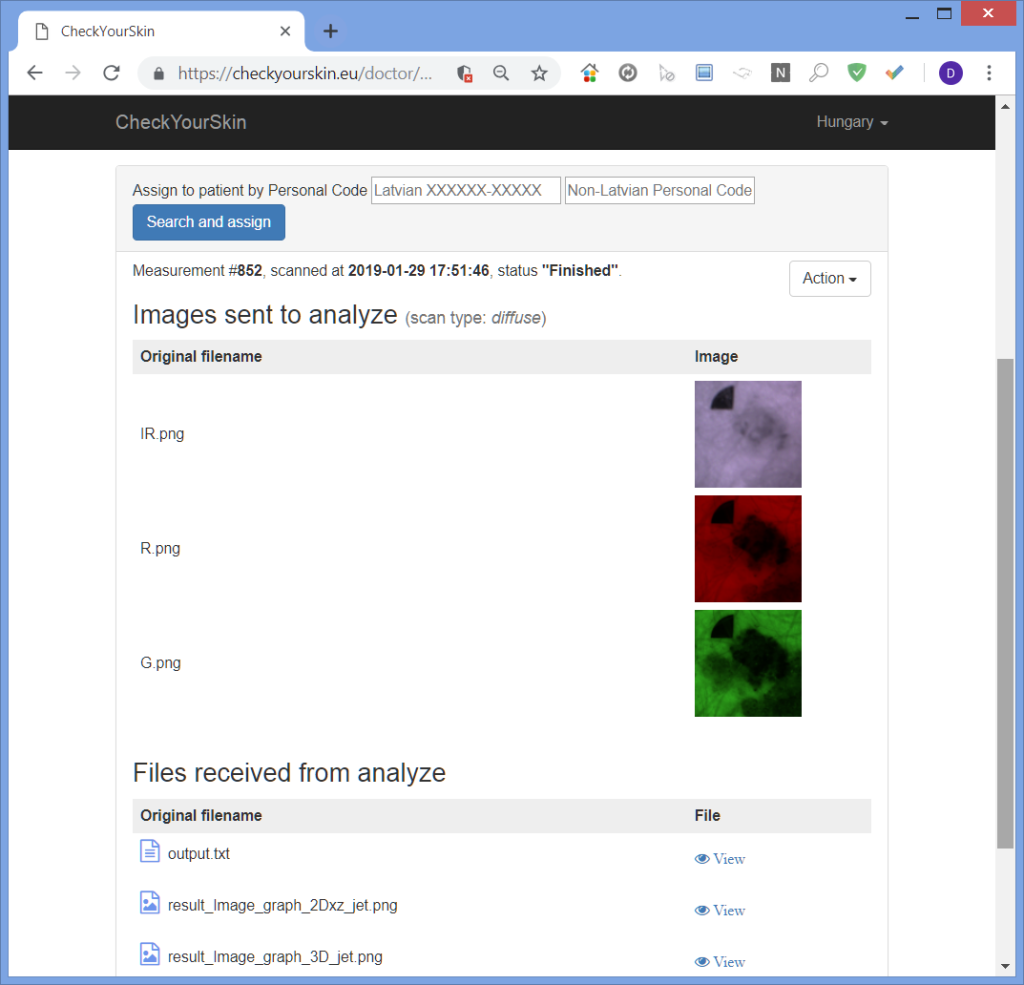
Online platform for images taken by the device.
A view into the future
“Like any medical technology startup, it is important to obtain a certificate, which is a very slow and complicated process,” explains Dmitrijs. “For now, we are preparing to define our aim – we are in a borderline situation where, on one hand, we are creating a device that only provides the doctor with information, but on the other hand, we are already offering a possible diagnosis. The latter is a much more serious function, and that type of device must be supported by in-depth clinical studies.”
As for the business model, Bdetect is intended to be introduced with an up-front deposit and a small monthly fee depending on the flow of patients. “It is easier with hospitals, but we have already talked with potential family doctor clients. Although some are interested, many refuse,” says Dmitrijs. “Both because there is no money for such spending (we hope that in the future we could arrange state funding), and – even if the use of the device is very fast – they also do not have time to deal with such a thing in practice. Knowing the workload of family doctors, this is understandable.”
N. Kiss emphasizes that more clinical studies with results that would allow increasing the sensitivity and specificity of the device are needed to improve diagnostics. The more data, the better the algorithm can be trained. It is also worth continuing to work on making the device as simple and convenient to use as possible, because it is already one of the strengths of this technology. The easier and faster doctors will get reliable results with its help, the higher the market demand will be.
“It is important to remember that, although today there is an effective therapy for melanoma, it is very expensive and has severe side effects, as is the case with all cancers,” says N. Kiss. “Therefore, prevention is of great importance – diagnosis of melanoma at the earliest possible stage, when a small surgical manipulation is effective. I believe that if Bdetect successfully spreads, then we will be able to help many patients cheaply and free up the resources of healthcare systems.”
This article was created in partnership with Medicus Bonus – a Latvian magazine for healthcare professionals – in a new series about healthcare innovation happening in Latvia. If you are a doctor, the subscription is free – just write to redakcija@medicusbonus.lv !
